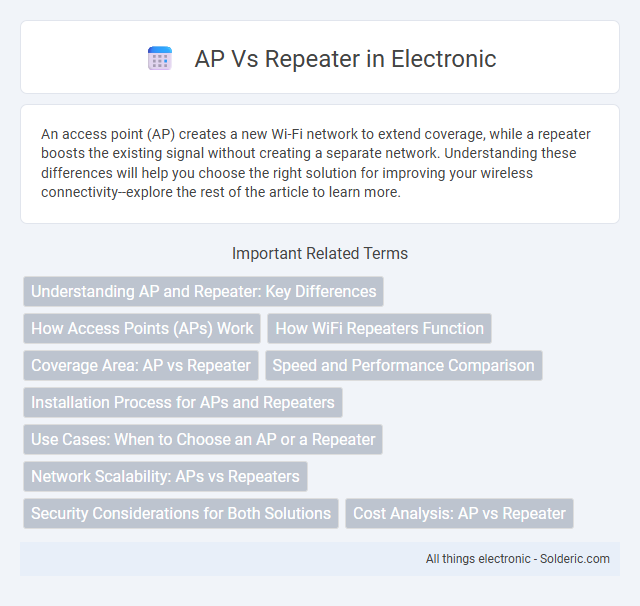An access point (AP) creates a new Wi-Fi network to extend coverage, while a repeater boosts the existing signal without creating a separate network. Understanding these differences will help you choose the right solution for improving your wireless connectivity--explore the rest of the article to learn more.
Comparison Table
| Feature | Access Point (AP) | Repeater |
|---|---|---|
| Purpose | Creates a new Wi-Fi network for devices | Extends the coverage of an existing Wi-Fi network |
| Function | Connects wired network to wireless devices | Receives and retransmits Wi-Fi signals |
| Network Role | Acts as a central hub for wireless clients | Acts as a signal booster |
| Connection Type | Wired LAN connection to router | Wireless connection to existing AP or router |
| Performance Impact | Provides full bandwidth | May reduce bandwidth due to signal rebroadcast |
| Usage Scenario | Creating new Wi-Fi zones in wired infrastructure | Extending Wi-Fi coverage in dead zones |
| Setup Complexity | Requires Ethernet wiring and configuration | Simple wireless setup, no wiring needed |
Understanding AP and Repeater: Key Differences
An Access Point (AP) connects wired networks to wireless devices, extending a primary network's coverage while maintaining original bandwidth and speed. A Repeater, on the other hand, amplifies and retransmits wireless signals to extend coverage but often reduces network speed due to signal degradation. Understanding these key differences helps you choose between enhancing your network's capacity with an AP or expanding its reach with a Repeater.
How Access Points (APs) Work
Access Points (APs) function by connecting wired networks to wireless devices, creating a seamless Wi-Fi environment for your devices to access the internet. They transmit and receive wireless signals within a specific coverage area, ensuring strong and stable connectivity. Unlike repeaters, APs manage network traffic efficiently by routing data between the network and wireless clients directly.
How WiFi Repeaters Function
WiFi repeaters function by receiving an existing wireless signal, amplifying it, and retransmitting the boosted signal to extend the coverage area. Unlike access points, which create a new wireless network by connecting directly to a router via Ethernet, repeaters wirelessly bridge gaps in WiFi coverage without additional wiring. This method helps eliminate dead zones but can reduce overall network speed due to retransmission latency and shared bandwidth.
Coverage Area: AP vs Repeater
Access Points (APs) provide a larger and more reliable coverage area by directly connecting to the main network, ensuring strong signal strength and consistent speeds across your home or office. Repeaters extend the existing Wi-Fi signal but often reduce bandwidth and may create signal weak spots due to signal retransmission. For optimal coverage and performance, deploying multiple APs is more effective than relying on repeaters.
Speed and Performance Comparison
Access Points (APs) generally provide faster and more stable connections than Repeaters because APs connect directly to the wired network, ensuring high-speed, low-latency data transfer. Repeaters extend wireless coverage by rebroadcasting the signal, which introduces additional latency and can reduce overall network throughput by up to 50%. For applications demanding high performance and consistent speed, APs are preferred over Repeaters, especially in environments with heavy data traffic or multiple users.
Installation Process for APs and Repeaters
Installing Access Points (APs) typically involves connecting them to a wired network via Ethernet cables, configuring their IP settings, and placing them strategically for optimal wireless coverage. Repeaters installation requires locating them within the existing Wi-Fi signal range to extend coverage without additional wiring, followed by pairing with the primary router through WPS or manual setup. Both devices demand careful positioning and network configuration to ensure seamless connectivity and performance enhancement.
Use Cases: When to Choose an AP or a Repeater
Access Points (APs) are ideal for extending wired networks into scalable wireless environments in enterprises, schools, or large homes, providing robust connectivity and centralized management. Repeaters are best suited for small-scale setups needing to boost Wi-Fi signals in dead zones without additional wiring. Choose APs for high-performance, secure networks requiring multiple concurrent connections, and repeaters for simple range extensions in existing wireless networks.
Network Scalability: APs vs Repeaters
Access Points (APs) provide superior network scalability by enabling multiple devices to connect simultaneously through a wired backbone, ensuring consistent high-speed coverage across larger areas. Repeaters, while extending wireless signals, often reduce bandwidth and increase latency due to signal regeneration, limiting the number of devices supported and overall network performance. Deploying multiple APs allows scalable, efficient network expansion essential for business environments requiring robust and reliable connectivity.
Security Considerations for Both Solutions
Access Points (APs) offer enhanced security features such as WPA3 encryption, integrated firewalls, and support for VLAN segmentation, making them ideal for protecting sensitive network environments. Repeaters primarily focus on extending signal range and often lack advanced security protocols, increasing the risk of data interception and unauthorized access. Implementing strong password policies, firmware updates, and network monitoring is critical for both APs and repeaters to mitigate potential vulnerabilities.
Cost Analysis: AP vs Repeater
Access Points (APs) generally entail higher upfront costs due to advanced hardware and integrated network management features, while Repeaters offer a more budget-friendly solution by simply extending existing Wi-Fi signals. Repeaters may increase operational expenses over time because they reduce network speed and can cause increased interference, potentially requiring additional devices to maintain coverage and performance. Your choice should consider not only initial expenditure but also long-term network efficiency and maintenance costs for optimal investment.
AP vs Repeater Infographic

 solderic.com
solderic.com